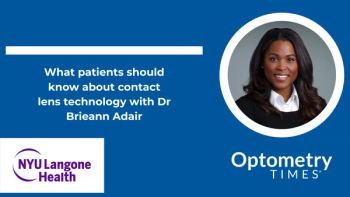
- March Digital Edition 2020
- Volume 12
- Issue 3
5 tips to keep presbyopes in contact lenses
Convenience, comfort, value, function, and expectations all play a role.
Help presbyopic patients continue to enjoy contact lens wear by emphasizing convenience, comfort, value, functional vision, and reasonable expectations. Don’t assume presbyopes are not interested in contact lens wear, won’t pay for daily.
Presbyopic patients are sometimes discouraged by the physical changes of age they are seemingly unable to influence. Instead of adding one more to the list, try opening a door for them.
Make a suggestion to try
These five tips will help to encourage presbyopic patients with contact lens wear.
Related:
1. Make it convenient
Perhaps we shouldn’t stereotype or make generalizations, but entering your forties sometimes comes with a newfound perspective. I may be a long-time member of the penny pinchers club, but I find myself paying for convenience much more frequently than I did in my twenties.
Well-meaning friends have said, “Which do you have more of: time or money?” and “You can make more money, but you can’t make more time.” Frequently, patients over 40 can finally afford conveniences that were previously sacrificed, and they now appreciate the time that affords.
What’s the answer to the convenience question when it comes to contact lenses? Daily disposables, of course! I cannot think of even one over-40 contact lens patient in my practice who has not been fit into daily disposables.
Related:
A great rule of thumb is to always assume your presbyopic patient wants the convenience of daily disposables until proven otherwise. Even if the patients insist on reusable lenses, send a strip of daily disposables home as a courtesy and to open their eyes to the convenience factor.
Related:
2. Make it comfortable
Comfort is just another aspect of convenience. In my experience, the presbyopic patient places a higher value on comfort, perhaps because he has now experienced the moments of compromised comfort that the aging eye can bring.
The first way to prioritize comfort is to be selective when choosing the contact lens material. Choose a highly wettable lens with a comfortable edge design and ample movement.
The second key component of maximizing contact lens comfort is to adequately address the underlying ocular surface disease. Remember that a contact lens splits the tear film in half and will likely create increased evaporation. Therefore, even if a patient does not have dry eyes without contact lens wear, she may experience challenges as a wearer.
It is always important to conduct a thorough ocular surface assessment or even dry eye evaluation before fitting a presbyopic patient in contact lenses. If signs are present in the absence of symptoms, it is often worthwhile to implement a proactive treatment to prevent discouragement and contact lens dropout.
Something as simple as a pharmaceutical twice a day or something quicker such as in-office intense pulsed light (IPL) treatment or thermal meibomian gland expression can have a dramatic effect on patients’ contentment and longevity as contact lens wearers. Even if there is excellent underlying ocular stability, remind your presbyopic patient to limit wear time in order to maximize visual and physical comfort.
Related:
3. Make it valuable
Presbyopes often treasure value more than price, so it is critical to create that sense of value.
Related:
Especially after the children grow older, adults sometimes become more social and active. Perhaps this is also a factor of financial stability or life perspective. If I had to guess, at least 70 percent of my patient population is retired. However, just today in the exam room I heard patients talk about their afternoon plans of playing bridge, playing golf, bowling, going antiquing, attending church, having lunch outside on the water, and selling cannabidiol (CBD) oil. I kid you not!
Seventy is the new 60, and 60 is the new 50. Because of that, there is a thirst for life that is sometimes unparalleled. The bottom line is that presbyopes value their quality of life, so be sure to celebrate those activities with them and ask if there are any they would enjoy more without their glasses.
4. Offer the freedom of functionality
Often as a presbyope ages, her friends will undergo cataract surgery. Friends may brag about how they no longer need glasses and can see distance and near without help. Sadly, your patient was told her cataracts were not “ripe” enough for such surgery.
This is the perfect opportunity to offer your patient a multifocal contact lens solution. Doing so will provide her with the flexibility to see distance and near and will give her a chance to experience multifocal optics before they become permanent.
Related:
Fitting patients with multifocal contact lenses will bring value today but also for years to come. Young presbyopes still work, and seniors are more active than ever. Help them imagine being able to read price tags; see the sign at the end of the aisle; to see to drive but also be able to view their speedometer, phone, or watch without glasses. Remind your retired ladies that they can throw on any style of plano sunglasses they choose as contact lens wearers.
Related:
5. Provide reasonable expectations
There may be a caveat to discuss with this age group. Often, younger patients are motivated by their appearance without glasses, which can be a more significant driving force leading to contact lens wear. Presbyopes can sometimes lack the determination to force contact lenses to work, perhaps because of their perspectives, or perhaps because the motivation to try contact lenses was not innate.
This means they may be more impatient and quicker to give up if vision or comfort is compromised. It is important to set clear expectations of comfort level, vision quality, and an appropriate wear schedule. Although this is true with any contact lens patient, it is especially so for the presbyopic patient.
I often tell patients wanting monovision that this modality is similar to wearing a tennis shoe and a high heel. Each eye is great at one thing but is not contributing to the work of the other. On the other hand, multifocal contact lenses offer blended vision in which the two eyes work together. Neither eye is perfect at distance or near, but together they often deliver better binocular vision than obtainable with monovision.
Remind patients there will still be times when they have to wear readers, such as low-contrast reading environments. Despite those moments, wearing multifocal contact lenses will significantly increase their functionality without glasses at both distance and near.
Related:
Related:
The bottom line: Don’t assume that your presbyopic patient is not interested, will not pay for daily disposables, or will not be able to adapt to multifocal lenses.
Encourage patients to live life to its fullest and let them see you as someone in their corner who is willing to help make that happen.
For your presbyopic patients who already wear contact lenses, consider proactive changes to the material, modality, and functionality of the lenses, as well as their ocular surface maintenance routine, in order to keep them in lenses for years to come.
Read more by Dr. Brimer:
Articles in this issue
almost 6 years ago
New-onset, atypical retinopathy in a patient with diabetesalmost 6 years ago
Pediatric headache: The vital role of the optometristalmost 6 years ago
Update on iris melanomaalmost 6 years ago
Use dark adaptation to screen before multifocal IOL implantationalmost 6 years ago
Unconventional clinical options for lowering IOPalmost 6 years ago
Optometry’s year can give ODs an edge with treatmentsalmost 6 years ago
New guidelines out for diabetes patient carealmost 6 years ago
The effect of contoured prism lenses on chronic headaches: a case studyalmost 6 years ago
Optometry’s role in multiple sclerosisalmost 6 years ago
How to create an ocular surface disease treatment protocolNewsletter
Want more insights like this? Subscribe to Optometry Times and get clinical pearls and practice tips delivered straight to your inbox.















































